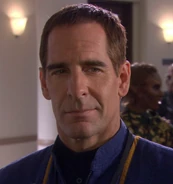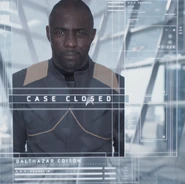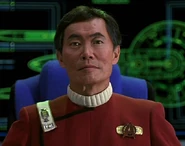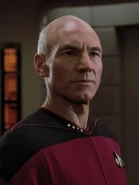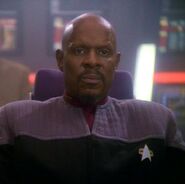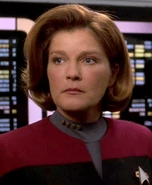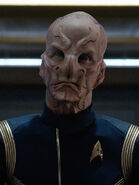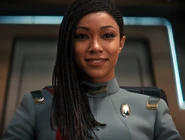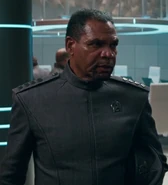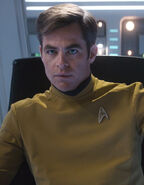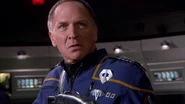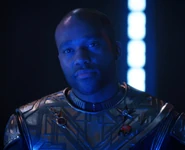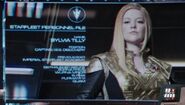mNo edit summary |
mNo edit summary |
||
| Line 6: | Line 6: | ||
|tab3 = ALT |
|tab3 = ALT |
||
|t1era = [[20th century|Mid - Late 20th century]] |
|t1era = [[20th century|Mid - Late 20th century]] |
||
| − | |t1image = US-O3 rank pin 1.png |
+ | |t1image = US-O3 LT rank pin 1.png |
| − | |t1caption = [[United States Air Force|US Air Force]]/[[United States Army|US Army]]/[[United States Marine Corps|US Marine Corps]] collar |
+ | |t1caption = [[United States Air Force|US Air Force]]/[[United States Army|US Army]]/[[United States Marine Corps|US Marine Corps]] collar or helmet insignia |
|t1era2 = [[1930s|Late 1930s]]-[[1940s|Early 1940s]] |
|t1era2 = [[1930s|Late 1930s]]-[[1940s|Early 1940s]] |
||
|t1image2 = SS patch captain.png |
|t1image2 = SS patch captain.png |
||
Revision as of 12:44, 8 March 2021
(covers information from several alternate timelines)
Captain was a commissioned officer rank, the equivalent of which was used by the service organizations of many civilizations. The title of captain was often used by vessel commanders and, as a naval rank, in many Earth navies and Starfleet, was above commander. As an infantry rank, captains ranked subordinate to a major and above a first lieutenant.
Earth history
On Earth, the title of captain was used as far back as the Middle Ages, where a captain was a nobleman commissioned to command a company of soldiers. One of the characters of William Shakespeare's play Henry V was quoted as saying "Under what captain serve you?" when approached on guard duty. (TNG: "The Defector")
By the 20th century, the rank of captain was common in Earth militaries and was used by all branches of service in the United States armed forces. The rank of captain was represented by a double rectangular silver bar uniform insignia for ground units and the equivalent of a colonel's eagle for naval captains. In 2364, the Q-entity took the form of a US Marine Corps captain when confronting Captain Picard. In this disguise, Q was quoted as stating "All it takes is a few good men." Q also appeared as a 16th century sea captain to the crew. (TNG: "Encounter at Farpoint")
The rank of captain was also used by World War II Germany. In the German army, the rank was translated as Hauptmann (headman), but in the SS, company captains were referred to as Hauptsturmführer ("head storm leader"). The collar insignia for this was a black square bordered with white, with three silver pips in a diagonal line, with two stripes underneath.
In a holodeck simulation of a Nazi campaign in France, a group of Hirogen pitted the crew of USS Voyager against holographic 1940s Germans. A US Army captain named Miller was the role assigned to Chakotay in the program; an SS Hauptsturmführer captain was another character in the simulation. (VOY: "The Killing Game", "The Killing Game, Part II")
In the 22nd century, T. Ginwald and T. Pine were captains in the United Earth Military. (Star Trek Beyond)
Starfleet captains
By the mid 22nd century, captain was a senior line officer rank of most space services and usually given to the commanding officers of starships. This naval rank was equivalent to the Romulan Star Empire's commander grade, the Cardassian Union's title of gul and the Ferengi Alliance's quasi-military DaiMon title.
Captains of starships, often located hundreds of light years away from and out of communications with higher authority, needed to be able to function autonomously and make independent command decisions affecting Federation policy and countless lives. Accordingly, few Starfleet officers ever gained the captaincy of a starship, the result of decades of sustained excellence as a Starfleet leader. (TOS: "Court Martial")
A senior captain given a large degree of responsibility or administrative assignment was sometimes given the title of fleet captain.
The rank of captain could also be held by non-command personnel, especially on ships with a number of veteran and senior officers whose experience had warranted advancement to the rank of captain but without command of a starship. Such was the case on the USS Enterprise-A, where the senior staff consisted of no less than three captains: the commanding officer (James T. Kirk), the first officer (Spock), and the chief engineer (Montgomery Scott). (Star Trek VI: The Undiscovered Country) Captain Scott had previously held his rank of captain while chief engineer of the USS Excelsior, where he was known as the "captain of engineering". (Star Trek III: The Search for Spock)
The rank of captain could also be held by staff officers, such as those assigned to as a Judge Advocate General sector officer. Such was the case with Phillipa Louvois, who was a sector JAG officer in 2365. (TNG: "The Measure Of A Man") Reaching the rank of captain in other non-command branches of Starfleet was generally considered difficult, as noticed by one security officer, who once remarked "You don't make captain by wearing a gold shirt". (DS9: "The Adversary") However, the rank was apparently obtainable in both the sciences and operations division, as the rank was held by Captain Krasnovsky in 2267, although he may have held command qualification while also being a science officer, and Vice Admiral Toddman presumably held the rank sometime before 2371. (TOS: "Court Martial"; DS9: "The Die is Cast")
Tryla Scott was said to have achieved the rank of captain faster than anyone in Starfleet history as of 2364. (TNG: "Conspiracy")
In the 2360s, K'Vada, Kargan, Korris, Kurn, Larg, and Tel-Peh were captains in the Klingon Defense Force. (TNG: "Heart of Glory", "Redemption II"; DS9: "Dramatis Personae") In the 2150s, Vorok was a captain in the Klingon Imperial Fleet. (ENT: "Unexpected")
When Lieutenant commander Data was asked in 2368 by Timothy why he wasn't captain of the Enterprise-D, Data explained that "My service experience does not yet warrant such a position." (TNG: "Hero Worship")
Some noted captains in Starfleet history were:
- Captain Jonathan Archer of Enterprise NX-01
- Captain Balthazar Edison of USS Franklin
- Captain Richard Robau of the USS Kelvin
- Captain Robert April of the USS Enterprise
- Captain Philippa Georgiou of the USS Shenzhou
- Captain Christopher Pike of the USS Enterprise and USS Discovery
- Captain Gabriel Lorca of the USS Buran
- Captain James T. Kirk of the USS Enterprise and USS Enterprise-A
- Captain Hikaru Sulu of the USS Excelsior
- Captain Jean-Luc Picard of the USS Enterprise-D and the USS Enterprise-E
- Captain Benjamin Sisko of Deep Space 9 and the USS Defiant
- Captain Kathryn Janeway of the USS Voyager
- Captain William T. Riker of the USS Titan and USS Zheng He
- Captain Carol Freeman of the USS Cerritos
- Captain Saru of the USS Discovery
- Captain Michael Burnham of the USS Discovery
The Starfleet of the alternate reality established in 2233 by the temporal incursion of the Romulan Nero had the following noteworthy captains:
- Captain Frank Abbott of the USS Bradbury
- Captain Christopher Pike of the USS Enterprise
- Captain James T. Kirk of the USS Enterprise and USS Enterprise-A
| Enlisted personnel | Commissioned officers | Flag officers | ||||||||||||||||||
|---|---|---|---|---|---|---|---|---|---|---|---|---|---|---|---|---|---|---|---|---|
| Fleet: | CRM | PO | CPO | MID CDT OC WO |
ENS | LT JG | LT | LT CMDR | CMDR | CAPT | FCAPT | CDORE | RADM | VADM | ADM | FADM | ||||
| Military: | PVT AMN |
CPL LCP |
SGT | SSGT | MSGT 1SGT |
2nd LT | 1st LT | CAPT | MAJ | LT COL | COL | BRIG | MAJ GEN | LT GEN | GEN | MARSHAL | ||||
| Services: | Andorian • Bajoran • Cardassian • Ferengi • Human (CSA • Third Reich • UE MACO • USA) • Jem'Hadar • Klingon • Romulan • United Earth/Federation Starfleet • Vulcan Mirror universe: Terran Empire Starfleet • Terran Empire MACO | |||||||||||||||||||
Memorable quotes
"That's the short definition of captain."
Appendices
Related topics
Background information
The lead characters in Star Trek productions have typically been Starfleet captains. In series television, these characters have included (in production order) James T. Kirk (William Shatner), Jean-Luc Picard (Patrick Stewart), Benjamin Sisko (Avery Brooks), Kathryn Janeway (Kate Mulgrew), and Jonathan Archer (Scott Bakula; the only difference when listed chronologically being that Captain Archer was before the other four captains). This format was the intention from the very first episode of Star Trek, "The Cage", wherein Captain Christopher Pike is established as the lead character. At first, the only exception to the captain-as-series-lead practice was when Sisko was portrayed as a commander during the first three seasons of Star Trek: Deep Space Nine, although Kirk was portrayed as an admiral, rather than a captain, in the first four Star Trek films. Also, the alternate reality version of Captain James T. Kirk has served as the lead character in three films – Star Trek, Star Trek Into Darkness, and Star Trek Beyond – but has never appeared in televised Star Trek. Other instances of breaking the captain-as-series-lead method are in Star Trek: Discovery, which portrays Captains Philippa Georgiou, Gabriel Lorca, and Christopher Pike as secondary characters to series lead Michael Burnham.
Regarding the challenge of following the legacy of so many extremely well-established series lead characters who had been Starfleet captains, Discovery Executive Producer Alex Kurtzman commented, "It's incredibly difficult to follow the amazing Starfleet captains that have already been created and beloved by so many. Every single one of them in different ways have been rendered so beautifully and so specifically that they're all tough acts to follow, but I'm sure that, when each one was being conceived, that the creators of those particular captains were scared about, you know, matching the one that had come before." ("Discovering Discovery: The Concepts and Casting of Star Trek: Discovery", DIS Season 1 DVD and Blu-ray special features)
The actors who have appeared in lead roles as Star Trek captains on television have been extremely varied. Jonathan Frakes remarked, "The five captains are so distinctive because of the five actors that play them, obviously. Patrick [Stewart] was cast against type, coming after Bill [Shatner]. Avery [Brooks], quite obviously, was cast against type, coming after Patrick. It was smart to bring Kate [Mulgrew] in, as a woman, and then Scott [Bakula] had an entire charm of his own. I think [...] whether it was planned or not, it was a very successful endeavor." (The Captains)
The Bajoran Militia, which also used army rank names, has been referred to by the Star Trek Encyclopedia as having a captain grade, with an insignia seen in episodes on officers subordinate to Major Kira Nerys, although they were never referred to by any specific rank in canon productions or materials.

